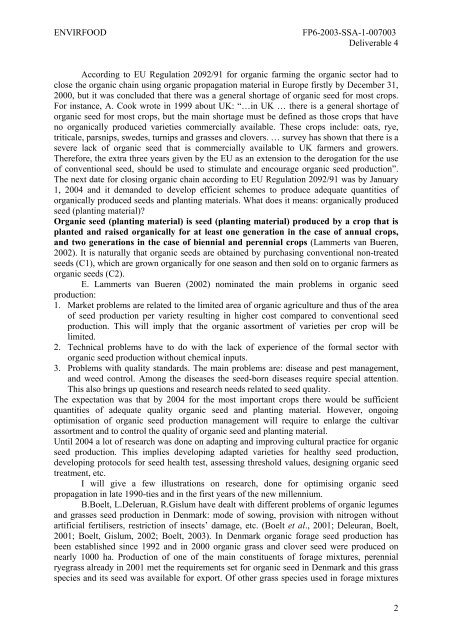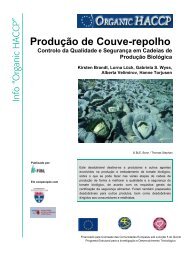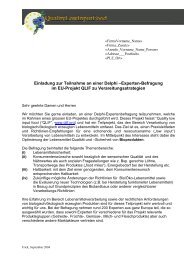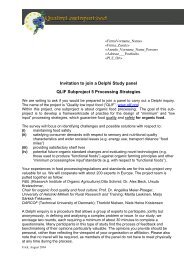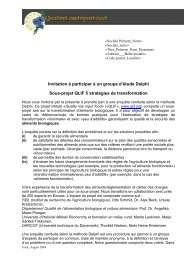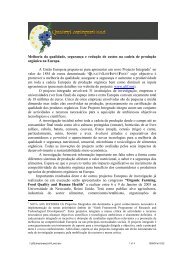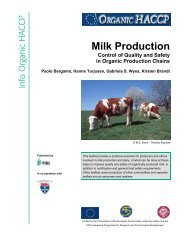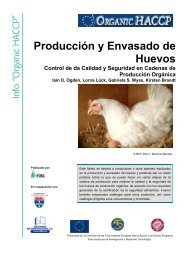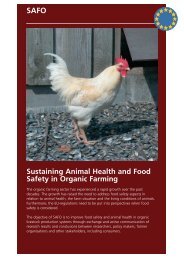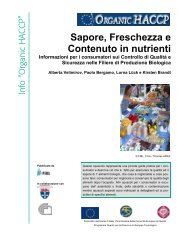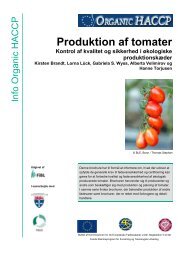ORGANIC SEED PROPAGATION: CURRENT STATUS AND ...
ORGANIC SEED PROPAGATION: CURRENT STATUS AND ...
ORGANIC SEED PROPAGATION: CURRENT STATUS AND ...
Create successful ePaper yourself
Turn your PDF publications into a flip-book with our unique Google optimized e-Paper software.
ENVIRFOOD<br />
FP6-2003-SSA-1-007003<br />
Deliverable 4<br />
According to EU Regulation 2092/91 for organic farming the organic sector had to<br />
close the organic chain using organic propagation material in Europe firstly by December 31,<br />
2000, but it was concluded that there was a general shortage of organic seed for most crops.<br />
For instance, A. Cook wrote in 1999 about UK: “…in UK … there is a general shortage of<br />
organic seed for most crops, but the main shortage must be defined as those crops that have<br />
no organically produced varieties commercially available. These crops include: oats, rye,<br />
triticale, parsnips, swedes, turnips and grasses and clovers. … survey has shown that there is a<br />
severe lack of organic seed that is commercially available to UK farmers and growers.<br />
Therefore, the extra three years given by the EU as an extension to the derogation for the use<br />
of conventional seed, should be used to stimulate and encourage organic seed production”.<br />
The next date for closing organic chain according to EU Regulation 2092/91 was by January<br />
1, 2004 and it demanded to develop efficient schemes to produce adequate quantities of<br />
organically produced seeds and planting materials. What does it means: organically produced<br />
seed (planting material)?<br />
Organic seed (planting material) is seed (planting material) produced by a crop that is<br />
planted and raised organically for at least one generation in the case of annual crops,<br />
and two generations in the case of biennial and perennial crops (Lammerts van Bueren,<br />
2002). It is naturally that organic seeds are obtained by purchasing conventional non-treated<br />
seeds (C1), which are grown organically for one season and then sold on to organic farmers as<br />
organic seeds (C2).<br />
E. Lammerts van Bueren (2002) nominated the main problems in organic seed<br />
production:<br />
1. Market problems are related to the limited area of organic agriculture and thus of the area<br />
of seed production per variety resulting in higher cost compared to conventional seed<br />
production. This will imply that the organic assortment of varieties per crop will be<br />
limited.<br />
2. Technical problems have to do with the lack of experience of the formal sector with<br />
organic seed production without chemical inputs.<br />
3. Problems with quality standards. The main problems are: disease and pest management,<br />
and weed control. Among the diseases the seed-born diseases require special attention.<br />
This also brings up questions and research needs related to seed quality.<br />
The expectation was that by 2004 for the most important crops there would be sufficient<br />
quantities of adequate quality organic seed and planting material. However, ongoing<br />
optimisation of organic seed production management will require to enlarge the cultivar<br />
assortment and to control the quality of organic seed and planting material.<br />
Until 2004 a lot of research was done on adapting and improving cultural practice for organic<br />
seed production. This implies developing adapted varieties for healthy seed production,<br />
developing protocols for seed health test, assessing threshold values, designing organic seed<br />
treatment, etc.<br />
I will give a few illustrations on research, done for optimising organic seed<br />
propagation in late 1990-ties and in the first years of the new millennium.<br />
B.Boelt, L.Deleruan, R.Gislum have dealt with different problems of organic legumes<br />
and grasses seed production in Denmark: mode of sowing, provision with nitrogen without<br />
artificial fertilisers, restriction of insects’ damage, etc. (Boelt et al., 2001; Deleuran, Boelt,<br />
2001; Boelt, Gislum, 2002; Boelt, 2003). In Denmark organic forage seed production has<br />
been established since 1992 and in 2000 organic grass and clover seed were produced on<br />
nearly 1000 ha. Production of one of the main constituents of forage mixtures, perennial<br />
ryegrass already in 2001 met the requirements set for organic seed in Denmark and this grass<br />
species and its seed was available for export. Of other grass species used in forage mixtures<br />
2


